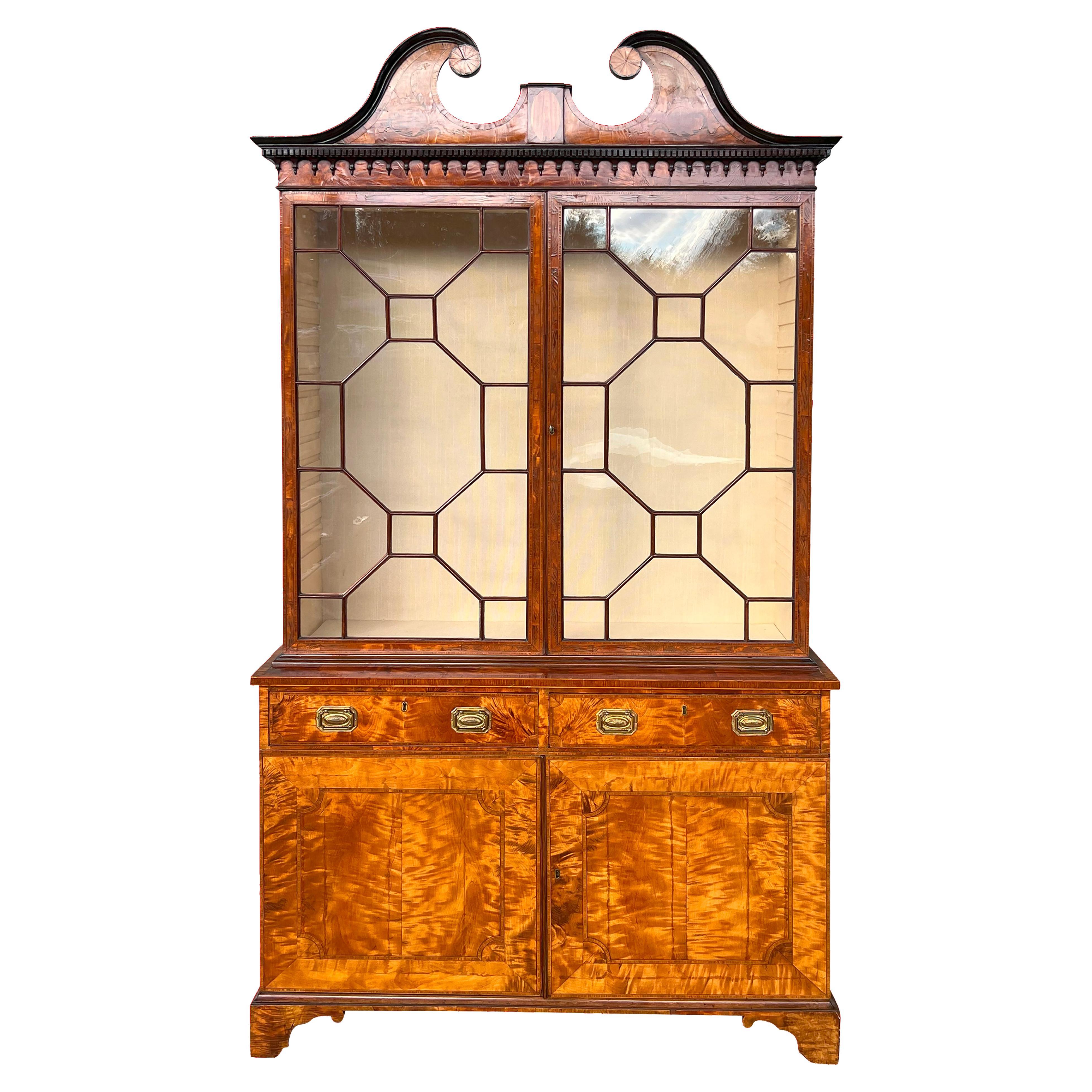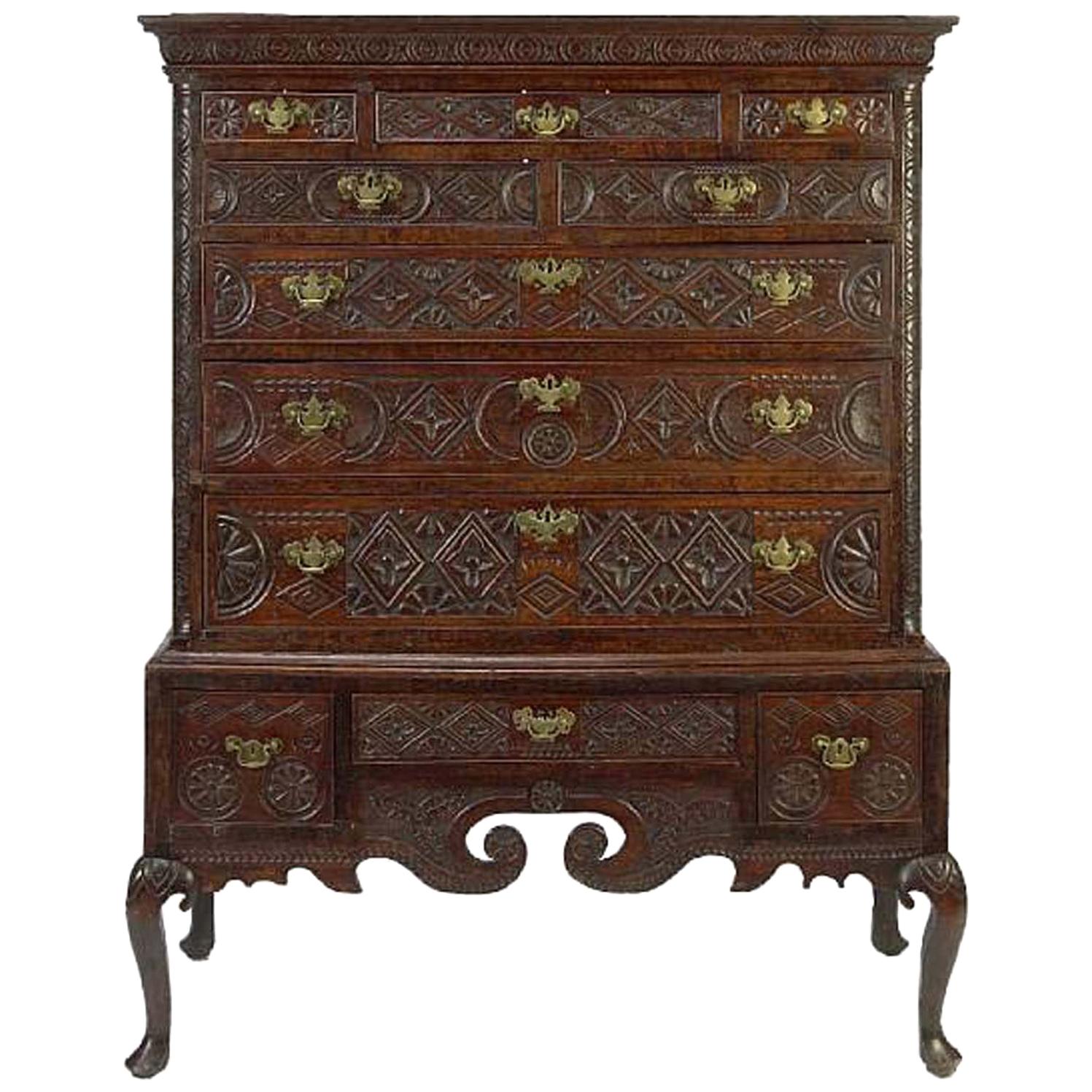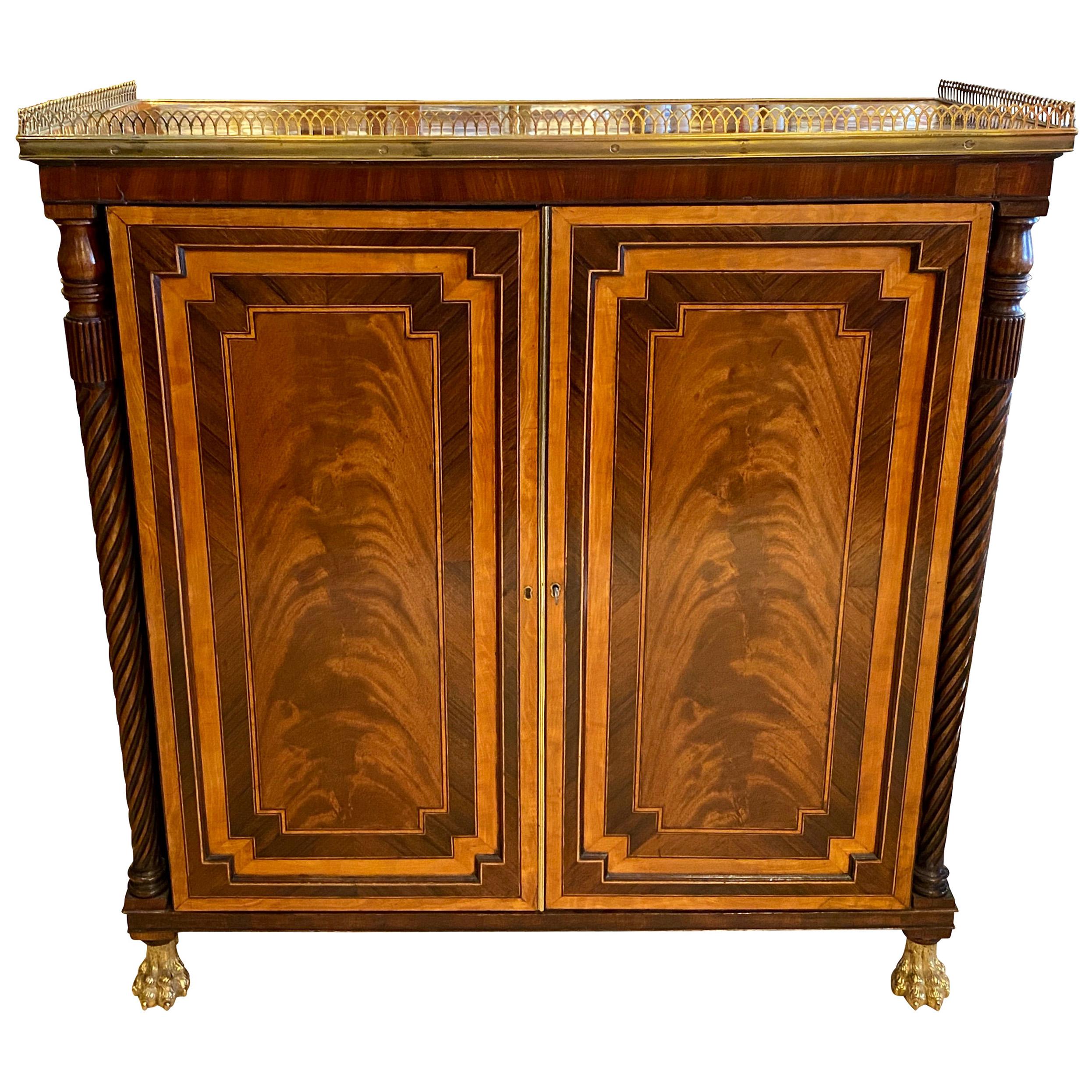Items Similar to An Important 18th Century George Iii Satinwood and Sabicu Writing Cabinet
Want more images or videos?
Request additional images or videos from the seller
1 of 14
An Important 18th Century George Iii Satinwood and Sabicu Writing Cabinet
About the Item
A fine late 18th Century George III Satinwood and sabicu ladies writing cabinet with important provenance. (Possibly by George Simpson)
English London made - Circa 1785
Provenance
Exhibited by W. R. Harvey in their Old Bond Street showrooms in 1986 and 1987, the piece being chosen to be advertised in Country Life magazine in 1986 and in the Grosvenor House Antiques Fair catalogue in 1987.
A private European collection.
This very elegantly drawn writing cabinet is constructed with the finest cuts of satinwood, banded with sabicu and strung with boxwood. The shaped and inlaid pediment with vase finials above a pair of glazed doors with patera-inlaid scrolled lower supporting brackets, over a pair of doors inlaid with oval mahogany panels enclosing pigeonholes, drawers and central lockable door. The lower section writing desk with in-curved front corners, with pull out writing drawer fitted with ratcheted reading slide, pen and crystal ink wells. The whole raised on slender tapering legs, headed with inlaid oval patera and strung with boxwood having collared feet.
An exceptional quality piece in superb original condition and of wonderful colour.
Dimensions
Width 34 inches - 86cm
Height 73 inches - 185cm
Depth 25 inches - 63.5cm
Ref 2896
- Dimensions:Height: 73 in (185.42 cm)Width: 34 in (86.36 cm)Depth: 25 in (63.5 cm)
- Style:George III (Of the Period)
- Materials and Techniques:
- Place of Origin:
- Period:1780-1789
- Date of Manufacture:Circa 1785
- Condition:Wear consistent with age and use.
- Seller Location:Benington, GB
- Reference Number:1stDibs: LU1183231425242
About the Seller
5.0
Vetted Seller
These experienced sellers undergo a comprehensive evaluation by our team of in-house experts.
Established in 1969
1stDibs seller since 2015
112 sales on 1stDibs
Typical response time: <1 hour
Associations
LAPADA - The Association of Arts & Antiques DealersThe British Antique Dealers' Association
- ShippingRetrieving quote...Ships From: Benington, United Kingdom
- Return PolicyA return for this item may be initiated within 3 days of delivery.
More From This SellerView All
- An Exceptional 18th Century Japanned Chest on Stand With Important ProvenanceLocated in Benington, HertsA Superb and Rare 18th Century European Japanned Chinoiserie Chest on Stand with important provenance. English Circa 1780 Provenance Villa Guaita, Cadenabbia, Lombardy (Italy) ...Category
Antique 1780s English Cabinets
MaterialsLacquer
- 18th Century Georgian Paper Scrolled Quilled Satinwood Tea CaddyLocated in Benington, HertsA wonderful 18th century George III quill work (scrollwork) tea caddy of hexagon form. English circa 1790 Finely executed, this very attractive caddy ...Category
Antique 1790s British Georgian Tea Caddies
MaterialsSatinwood
- Rare 17th Century Neapolitan Ebony Tortoiseshell and Mother of Pearl CabinetLocated in Benington, HertsRare 17th Century Neapolitan Ebony Tortoiseshell and Mother of Pearl Cabinet From the Perego Collection in Monza, an important 17th Century Italian arch...Category
Antique 17th Century Italian Cabinets
MaterialsTortoise Shell, Mother-of-Pearl, Ebony
- Fine Regency Amboyna And Ebony Inlaid Gilt Bronze Mounted Shaped CabinetLocated in Benington, HertsOf outstanding quality, an early 19th Century Regency ormolu mounted amboyna and ebony shaped side cabinet on tapering legs English circa 1810. Finely decorated with ebony bea...Category
Antique 19th Century English Regency Cabinets
MaterialsEbony, Amboyna
- Rare Pair of 17th Century Spanish Baroque Gilt Bronze Mounted Ebonised and TortoLocated in Benington, HertsAn Exceptional and rare pair of 17th Century Spanish Baroque gilt bronze and metal mounted ebonised and tortoiseshell cabinets of grand scale with Provenance. Spain circa 1680. The moulded top above a central door of architectural form with a niche and the standing classical figure of Athena flanked by dual pairs of Tuscan pillars, to the door reverse being segmented walnut and inlaid with ebonised geometric banding, opening to reveal five tortoiseshell and ebonised fronted drawers with gilt stars and ring handles, the bottom drawer concealing a further secret drawer to the rear. The portico being flanked by eight conforming drawers retaining steel locks and gilt escutcheons. The sides with segmented walnut and inlaid geometric banding and ebonised mouldings together with iron drop carrying handles, on gilt metal clad claw ebonised ball feet. Provenance - purchased by Mr Stuart Fearnley of Rose Green Farm...Category
Antique 17th Century Spanish Baroque Cabinets
MaterialsTortoise Shell, Ebony
- Important Regency Mahogany Partners Writing Table in the Manner of George SmithBy George Smith, Charles NormanLocated in Benington, HertsA highly Important, Early Regency period mahogany, ebonised and parcel-gilt partners writing table on monopodia legs of exceptional quality and design, in the manner of George Smith, stamped Chas Norman, whom was associated with the work of Gillows. Labelled ‘Morning Room’. English, Regency period, circa 1810. Rarely seen, the crescent shaped ended rectangular top, beautifully lined with the original gilt tooled leather writing surface, enclosed by a mahogany cross-banded border and reeded edge. The frieze, containing four finely chosen fiddle-back mahogany drawers, two pairs to opposing sides, each retaining the original gadrooned carved ebonised knob handles. The perimeters having a finely ebonised cockbead, whilst the drawer liners being executed in mahogany retain the original recessed brass locks, which look to have never been removed. Flanking the drawers are bead-moulded ebonised panels which conform to either end above a reeded mould. Raised on four boldly designed and imposing, crisply carved, ebonised and parcel-gilt leopard monopodia supports, of wonderful original waxed condition. The Egyptian leopards mask above a bold breast decorated with carved gilt anthemion and guilloche motifs, finishing on a finely detailed carved leg and paw foot. The condition is excellent, retaining the original hand-dyed and gilt tooled waxed leather writing surface along with original locks, handles and ebonising with gilt-work to the legs. Commissioned for what presumes to be a private collection and due to its condition, being obvious to see, this writing table has been home to an important household. Labelled ‘Morning Library’ to the underside, whilst in this exemplary condition strongly suggests this striking piece of Regency furniture has furnished the library of the said house for the majority of its life. As can be noted, this is an extremely rare, elegant, early Regency writing table of exceptional colour, which corresponds with designs of the celebrated furniture maker and designer George Smith, workmanship of Gillows, being stamped to the underside Chas Norman four times. George Smith (1756 - 1826) was one of the most influential furniture designers of the English Regency Period (1811-1830). Smith, who began his pattern-book in 1804, wrote of ‘the great taste and elegance’ of this design. In 1808 he published his influential and definitive text on Regency interior Design titled ‘ A Collection of Designs for Household Furniture and Interior Decoration’ and classed himself as ‘Upholder Extraordinary to His Royal Excellency the Prince of Wales’…The Prince Regent. Smith was inspired in his designs from his earlier career as an Egyptologist, producing drawings incorporating motifs of Leopards heads and paws, Lions, sphinx’s, anthemia, and griffons amongst others. Charles Heathcote Tatham (1772-1842) published ‘Etchings, Representing the Best Examples of Ancient Ornamental Architecture; Drawn from the Originals in Rome, and Other Parts of Italy During the Years 1794, 1795, and 1796’, in which he illustrated an antique tripod table...Category
Antique 1810s British Regency Desks and Writing Tables
MaterialsMahogany, Giltwood
You May Also Like
- George III Satinwood CabinetLocated in Essex, MAIn two parts. The upper section with a broken arch cornice with inlaid pinwheels at the termination of the scrolls. Central oval inlay in the center. Two glazed and mullioned doors i...Category
Antique 1780s English George III Cabinets
MaterialsSatinwood
- 18th Century George III Carved Oak Highboy CabinetLocated in Cypress, CA18th century George III carved oak highboy cabinet on stand. The superstructure is topped by a moulded rectangular cornice over nine graduated drawers...Category
Antique 18th Century George III Dressers
MaterialsBronze
- 18th Century English Mahogany George III Display CabinetLocated in Pasadena, CAGeorge III display cabinet. Upper section with two glass doors, lower section having two cupboard doors enclosing two lined shelves. Hidden ...Category
Antique 18th Century English George III Cabinets
MaterialsMahogany
- George III Mahogany and Satinwood Book CabinetLocated in Essex, MAFinely constructed with choice veneers with crossbanded top with brass 3/4 gallery over a pair of paneled doors with a pair of opposing doors with pleated fabric, each corner with re...Category
Antique Late 18th Century English George III Bookcases
MaterialsMahogany
- Fine George III Period Satinwood Secretaire CabinetLocated in Lymington, GBAn exceptional English Sheraton period satinwood secretaire cabinet. Attributed to Gillows. Late-18th century, George III, ca 1790. Measures: H 59 1/2’’ (151 cm) W 30’’ (76 cm) D 19’’ (49 cm). This small, beautifully-proportioned, and sophisticated antique writing cabinet...Category
Antique Late 18th Century English George III Secretaires
MaterialsSatinwood
- Rare and Important English Cabinet George I in Partridge's Eye 18th CenturyBy English SchoolLocated in Madrid, ESGeorge I cabinet with elevation English, in mahogany and partridge's eye 18th Century. Top with two interior doors with drawers, door and bins. Bottom with two drawers and two bi...Category
Antique 18th Century English George I Cabinets
MaterialsWood
Recently Viewed
View AllMore Ways To Browse
Antique Fair
Oval Cabinet
Oval Storage
Curved Front Cabinet
18th Century Fine George
18th Century Inlaid Cabinet
Satinwood Band
Pediment Case
Banded Satinwood
Important English
Important English Furniture
Curved Leg Storage Cabinet
Exhibit Case
Antique Kitchen Pulls
Important Mahogany
Antique Ink Well
Antique Ink Wells
Ink Wells Antique





